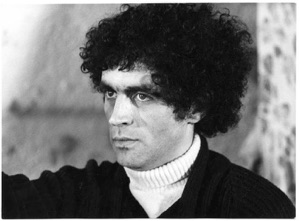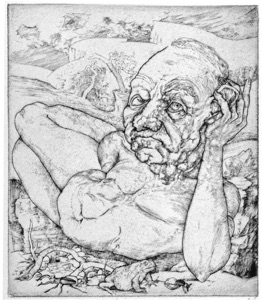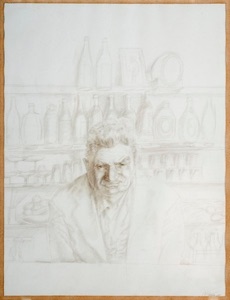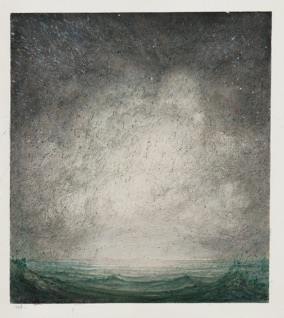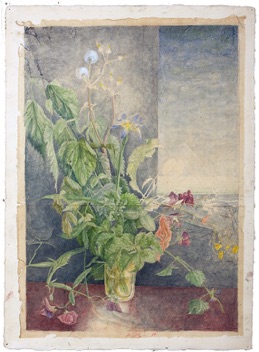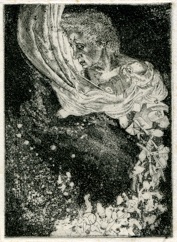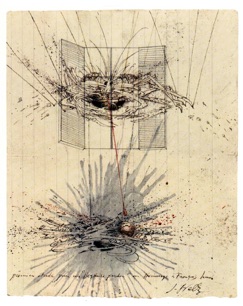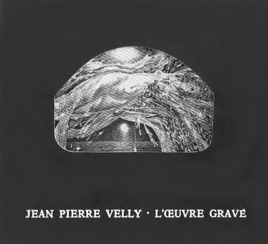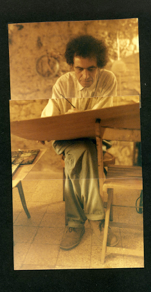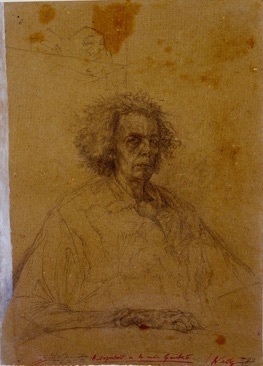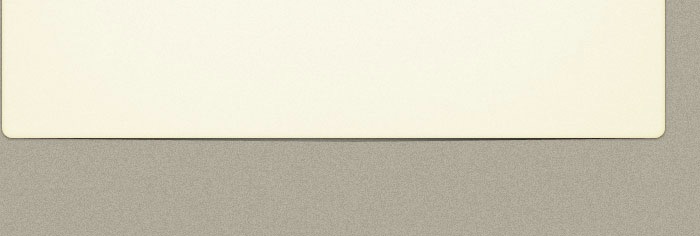Interview with
Giuliano de Marsanich, Velly’s friend and dealer for 20 years
by Pierre Higonnet, June 2009
P.H. Giuliano, tell me a little bit about your background.
G.D.M. I was born in 1929. I come from a Roman family, a regular one, traditional, fascist ... normal all things considered ! (he smiles). My father was a high ranked Civil servant, a righteous, delicate fellow; nowadays you would say “an elderly gentleman”. And it’s my father who gave me the taste for culture (he was passionate about History). We were very close and I missed him, I still do today. My mother was much younger, she was very likable as well ...
P.H. As a youth, were you attracted by paintings ? by classical art ?
G.D.M. Oh no, not at all! I was a “balilla”, a youth in the Fascist movement which pointed to “courage, heroism, force, and guns” (he smiles). My studies were interrupted in 1944, during the German invasion which lasted nine months. They were dreadful days of death and hunger. These events created a very deep fracture with “normality”. I thought absurd to go to school and learn Greek when a few feet away people were being murdered. Although my cursus was irregular, I passed the final examination and went off to University where I was pretty good. But soon enough I grew tired of the atmosphere and decided to turn artist. I opened a small studio of ceramics with an oven and this was the beginning ... of the end ! (he laughs). This took place in the late Fifties, our “bohemian” period which lasted quite a few years.
P.H. When and how did the Gallery Don Quijote came about ?

P.H. Did the gallery follow a specific line ?
G.D.M. In part only. To be honest, I was following two different tracks: the first one was the Roman school of the time, with shows of Guttuso5, of Cagli6, of Maccari7, very typical Roman artists of that period. There was however another line that was more congenial to me: I have always been fascinated by the Fantastic, which in Italy was pretty rare. Therefore, I started to work with Czech and French artists and a few others, all of them absolutely unknown to the Italian public. I’m speaking of Brunovski8, Anderle9, Cinovski10 and Fuchs11 . For France, I started with Jean-Pierre Velly.
P.H. But this happened about ten years after you had opened the gallery; I guess it was doing pretty well, right?
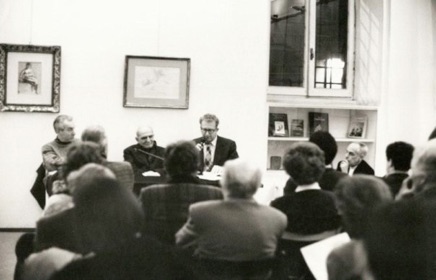
P.H. Let’s talk about that first encounter with Velly arranged by Domenico Petrocelli16 , a columnist that you knew from before ?
P.H. Is that what is called a love at first sight, right ?
G.D.M. Absolutely, but as it turns out in life, our relationship became stronger with time. You have to understand that it was not just a matter of economic partnership - that part existed as well of course - but a much more complex relationship, of great love and respect I’d say... and it was mutual.
P.H. Tell me about your first show together.
G.D.M. It was an exhibition of etchings exclusively: I remember it was a incredible success, way beyond what we expected.
P.H. I understand because Velly’s etchings are not easy to read or decipher, they are not decorative...
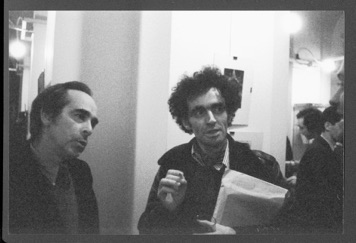
Etchings at the time sold well. There were three top engravers at the time: first and foremost was surely Morandi17. Then came Viviani18 and finally Bartolini19. And I had exhibitions of all three of them. There was also Vespignani, a very gifted printmaker as well.
P.H. Did you realize at the time that your latest “rookie”, sooner or later, was going to “deliver” ?
G.D.M. I wouldn’t use those terms. I immediately had the certainty that the direction that this young man was taking would always go up. Culturally, what he had to offer was “beyond” or again “apart” of mainstream postures of the time. In any event, I was so confident about the greatness of his art that I never doubted that one day or the other his talent would be widely recognized.
P.H. Was Velly aware of his great talent?
G.D.M. At times, he would make fun of his works; but deep down, he was very well aware that his art was sacrosanct. And it’s no surprise that his life was so intimately bonded with his art. It’s a extremely rare case, the only other one I know about is Morandi.
P.H. How did Velly live ?
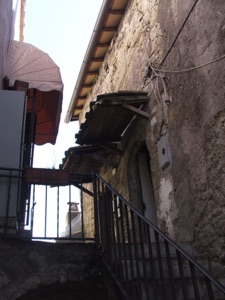
P.H. Can you tell us why he chose to stay on in Italy (after his three and a half year scholarship at the French Academy in Rome) rather than going back to France ?
G.D.M. For several reasons. First of all, rental fees in a small town such as Formello were very low, but in fact he was fascinated by our country with which he had a fabulous relationship of passion and love ... for its scenery, for its culture.
P.H. I imagine that this passion must have been very strong since he declined the engraver’s chair at the prestigious Paris Ecole Polytechnique, a prominent position for a young artist. I believe he didn’t want to be a “teacher”, he wanted to live free his artist life... All the same in 1972, you mounted a second show, this time only made up of silverpoint drawings, which subject matter were entirely different from his etchings. There were mainly portraits of townspeople of Formello: kids, youths, men, women, elderly folks, even animals.
P.H. But don’t you think that drawing portraits of Formello’s people was in a way for him to introduce himself to this new environment where he knew just about no one ?
G.D.M. It’s well possible. He spoke Italian, not perfectly but well enough. He eventually took a old derelict house that he remodeled with his own hands; it turned out a very nice house, fascinating place really.
P.H. By the way, as we are working on the catalogue raisonné, it appears that Velly’s output between 1973 and 1975 is meager, I mean in terms of quantity: less than a dozen etchings and a handful of drawings. Now I understand that he had been working on his house, but still... In your recollection, did the artist undergo some kind of creative crisis during this specific period?
G.D.M. I don’t remember, I can’t give you an adequate answer to your question.
G.D.M. Oh never, never ! I wouldn’t have allowed myself to tell him what to do ! I was just happy that he went back to painting, watercolors and such, producing really beautiful things, totally out of the ordinary. I never induced the idea that he should replicate a landscape because the public had liked it. I had for him the upmost respect...
P.H. How about the flowers in a vase ?
G.D.M. Listen, you have to understand, it’s a natural thing, and it would have been strange otherwise. What I mean is : meeting with success, often times enthusiasm with a specific subject matter, can only please you, right ? We all are happy when we get recognition for our labors. He was not merely enchanted by the vegetal world, he had a kind of osmosis with Nature. Actually, it’s so self evident that a lot of his works are autoportraits, I mean even when he isn’t in them ...
P.H. I couldn’t agree more. I also believe that Jean-Pierre’ s works are very autobiographical.
G.D.M. Indeed, it’s incredible.
P.H. What kind of relationship did Velly have withe other artists of the gallery ?
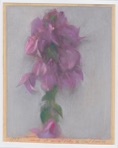
G.D.M. Not much because what happened to Lunven had caused him a lot of pain
P.H. It is a pity, because his artistic bond with Lunven is extremely relevant. They etched side by side at the Lacourière-Frélaut printmaker workshop, something that he never repeated afterwards. We are currently studying the relationship between these two great artists and there is no doubt that they influenced each other. Catherine Velly29 told me that the etching Ciel étoilé is a portrait of François Lunven, a hommage to the late artist. Lunven certainly made a great impact on Velly.
P.H. When did you become Jean-Pierre’s exclusive dealer?
G.D.M. “Dealer” is not the exact word I’d use, because our bond, in my opinion the only one possible with someone like him, was not only business; it was much more complex and subtle... But yes indeed I was his dealer it’s true...
P.H. It must have been very confortable for him your handling of all his works ?
G.D.M. In a way yes, I did take away a thorn off his thigh. But what you must know is that I have never been very entrepreneurial! I just waited, that’s all... I never went out to convince God knows who ... We just waited for people to come to us. And sometimes we had to wait a long time !
P.H. So we were mentioning the fact that Jean-Pierre etched less and less as he started to paint again. Towards the end of the 70s’s, there is a turning point for you as for Velly with the appearance of Lucio Mariani30.
G.D.M. It’s true. I was a very close friend of Lucio’s sister, Emilia. With Lucio, we had a very constructive relationship; he had a great significance, no doubt about it: he even became my partner in the gallery for a few years.
P.H. Establishing the catalogue raisonné of the artist’ s unique pieces (drawings, watercolors, paintings), we’ve realized that scores of Lucio’s business partners acquired works...
G.D.M. Yes...
P.H. We are talking about major industrialists and celebrities ...
G.D.M. Absolutely! Lucio loved Jean-Pierre very much, who was a very amiable character, almost impossible not to appreciate, someone who staggered with his strange twists...
G.D.M. You know, before allowing a artwork to leave the studio, he would rework it, retouch it, look at it for hours. From the studio, he would let out only prime quality work - unlike most artists believe me ! He’d spend hours and hours in his studio. All of his pictures that came out were perfect, truly beautiful.
P.H. At a certain point, you were buying the entire production. Wasn’t it painful for Velly to remit all of his works like that ?
G.D.M. No, no, no, absolutely not ! He would paint... and then we had our understanding.
P.H. Did he discard works at times ?
G.D.M. According to me, he threw nothing. He might have put things aside, hidden stuff. He had a medieval rapport with his art, his “trade”: his life was his work. His studio resembled a Middle Age workshop. And believe me it was very striking... full of dead bats, sculls, bones, dragonflies... something unbelievable! This might sound contrived like a certain decadent literary allure, but not at all : all these things were all true for him. Let’s take an want-to-be “artiste maudit”: place a scull, there ... you can immediately sense that’s artificial; on the contrary, Velly felt them, breathed into them, depicted them.
P.H. Did Velly changed at all during the course of your friendship which lasted twenty years ?
G.D.M. There were phases, moments. But he was always his true self. Life is not in a strait line. There are curves and swerves... but at the end - and not only for him but for about everyone around - one rediscovers his first identity of the first early years. A man, lets say at the end of his life, comes back to his first love. There is a intermediate phase where we are in some fashion conditioned by others: in your work, the things you say - we all did it, didn’t we? When that’s out of the picture, you can have the luxury to go back to where and when you were young...
P.H. Can you talk to me about Giorgio Soavi32 who loved Velly so much ?
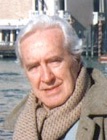
P.H. As it appears to me, Barilla might have purchased about twenty pictures by Jean-Pierre.
G.D.M. Maybe even more ...
P.H. What did Jean-Pierre read ?
G.D.M. He was enthralled by Céline, which I share totally. He also liked Queneau34 he thought was fun, but he was closer to Céline. Naturally there was Tristan Corbière. Jean-Pierre had his own culture which was not scholarly. He wasn’t interested in politics, not that he was against. No, it was more like a mountain: there is fascism, communism, monarchy ... these things leave the mountain indifferent. He was kind of like that. However, he did listen to the radio, which kept him company.
G.D.M. You know, he’d never go to the movies: for him to get out from home, drive, park, no smoking, buy the ticket, all of this was a drag, often not repaid by the quality of the movie. He didn’t like to travel much, and I believe he never boarded an airplane.
P.H. In fact, he went to Germany once or twice to visit Reinhold Kersten35, a few times to Switzerland, to Spain... He went to France every year though! To Paris, to Brittany...
G.D.M. When he went to Brittany, he’d go with his old “deux-chevaux” car !
P.H. Do you think he had some kind of nostalgia of France ?
G.D.M. No, I don’t think so. He never spoke of it, aside for his mother. She came down several times. They looked identical, it was incredible!
P.H. Tell me about the Paris FIAC Art Fair36 of 1982.
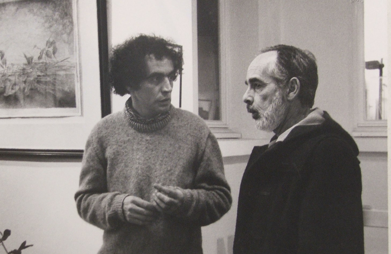
P.H. Why did he say that? were they too expensive ?
G.D.M. In his opinion they were. My hand on my heart I said to him: “Too bad ! ” We had a small booth and it was ... a tremendous success ! We sold everything we brought. The funny thing is that people payed in cash - can’t remember why - and said: “Please count!” And we’d say: “We wouldn’t dream of it !” As soon as they were off, we’d go behind the booth and count ! It was glorious! We even sold works to the French gallery owner Claude Bernard38. And it was there that Ettore Gian Ferrari39, Claudia (who runs the gallery today)’s father, saw Jean-Pierre’s works for the first time. He was thunder struck and quickly organized a solo exhibition in his Milan based gallery.
P.H. How about the Forni Gallery40?
G.D.M. Yes, they also did a show of Jean-Pierre.
P.H. Let’s talk if you wish about the 1989 San Severina Gallery exhibition in Parma.
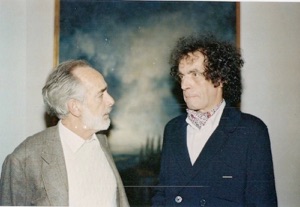
P.H. But Jean-Pierre must have held Sgarbi in high esteem because what he wrote was really ...
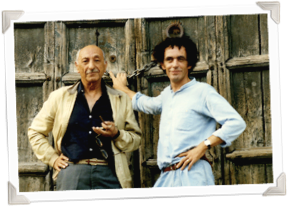
P.H. Of all these art critics with whom Velly was closest to ? Lorenza Trucchi42, Marisa Volpi43 ?
G.D.M. Most of them he liked, but also Fausto Gianfranceschi44 and Alberto Moravia! With Moravia we were several time in Formello for dinner. Velly had a good relationship with them. But never any more than that, you understand?
P.H. Can you tell me what happened on the day of the tragedy ?
P.H. It’s a shame he didn’t write more...
G.D.M. Yes, it’s true, he could have written beautiful things. But you know, he just was like that...
P.H. Tell me about the portrait he did of you...
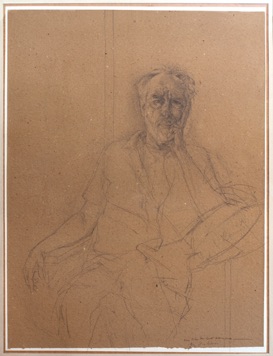
P.H. You mean there were several sessions ?
G.D.M. Yes, these sessions were wonderful because I had to look at him. It’s going to sound a bit emphatic but I swear that he looked just like a priest celebrating mass. There was a bond, way beyond our traditional rapport... When one has had such a relationship and the other is gone missing, it’s impossible to forget or substitute with another.
P.H. Thank you Giuliano for this moving testimony on your friend Jean-Pierre Velly.
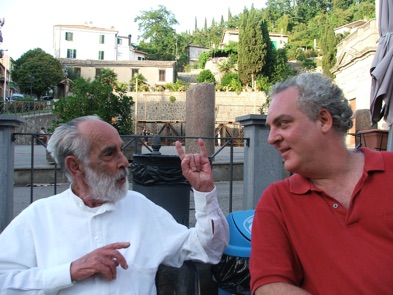
Giuliano de Marsanich and Pierre Higonnet 2006
1 Renzo Vespignani (1924-2001), painter and printmaker, founder of Il pro and il contro, with Piero Guccione, Ugo Attardi, Ennio Calabria, Giuseppe Guerreschi and Alberto Gianquinto.
2 Ugo Attardi (1923-2006) was a painter, sculptor and printmaker. In 1948, with other artists (Carla Accardi, Pietro Consagra, Piero Dorazio, Mino Guerrini, Concetto Maugeri, Achille Perilli, Antonio Sanfilippo and Giulio Turcato) founds the mouvement Forma 1. Will eventually turn figurative and joins Il pro and il contro.
3 Mario Lattes (1923-2001) was a painter, a writer and a publisher from Turin. A Foundation bears his name in his home town.
4 Alberto Moravia (1907-1990), the celebrated Italian writer is Giuliano de Marsanich’s first cousin.
5 Renato Guttuso (1911-1987) was a celebrated painter of the Roman school, he eventually joined the artistic movement “Corrente” which opposed official culture.
6 Corrado Cagli (1911-1976) painter. Joins the Roman school and eventually went closer to De Chirico, Ernst and Klee ideas..
7 Mino Maccari (1898-1989) was a writer, painter, printmaker, journalist and comic book draughtsman.
8 Albin Brunovsky (1935-1997) was a printmaker and a painter of the school of the Fantastic; he also taught many years at the Bratislava Academy.
9 Jiri Anderle (1936, Pavlikov, Bohème) is an well known printmaker, works in Prague.
10 Martin Cinovsky (1953) was Albin Brunovsky student at the Bratislava Academy. Printmaker, he specialize in stamps and bills. Is the current director the Printmaking department at the Bratislava Academy.
11 Ernst Fuchs was born in Vienna in 1930. Painter, printmaker and architect a Museum is dedicated to him in his home town.
12 Giorgio Bassani (1916-2000). War hero and writer, he is the one who brought Il gattopardo (the Leopard) to Feltrinelli. His novel The garden of the Finzi-Contini (1962) was a best seller. Went on to work for television.
13 Bernardo Bertolucci (1941) celebrated Italian movie director and producer.
14 Luca Canali (1925) is a Italian writer and a faculty member of several universities.
15 Ugo Tognazzi (1922-1990) the famous comic actor, symbol of the Commedia all’italiana.
16 Domenico Petrocelli was a columnist for the roman newspaper Il Tempo. He met Velly in 1969 and helped him with shows, to establish himself in Formello and introduced him to Giuliano.
17 Giorgio Morandi (1890-1964) was a celebrated painter and printmaker from Bologna.
18 Giuseppe Viviani (1898-1965) was a painter and printmaker.
19 Luigi Bartolini (1892-1963) was a painter, a writer, a poet, art criticand printmaker.
20 Tristan Corbière, poet (1845-1875), he is one of “poètes maudits” de Verlaine, alongside Rimbaud, Nerval and Mallarmé. The catalogue “Velly pour Corbière” was published by Don Quijote Gallery for the 1978 exhibition.
21 Mordechai Moreh, born in Baghdad in 1937 is a printmaker and painter, works in Paris.
22 Erik Desmazières (born in Rabat in 1949) is a celebrated printmaker, works in Paris.
23 Yves Doaré, born in Brittany in 1943, is both a printmaker and a painter. Works in Quimper.
24 Jacques Le Maréchal was born in Paris in 1928; self-taught, he is a printmaker and a painter. Velly had him in high esteem.
25 Piero Guccione was born in Scicli (Sicily) in 1935. He is a celebrated Italian painter renown for his pastels.
26 Pedro Cano was born in Blanca, Spain in 1944. Painter and watercolorist, he lives and works in Anguilara, near Rome.
27 Edo Janich was born in Pordenone in 1943. Assistant to Ugo Attardi in Rome in the ‘60, he is a printmaker and sculptor.
28 François Lunven (born in 1942) was a brilliant printmaker and painter. They meet in Paris in 1965. He will throw himself out the window of his studio in 1971.
29 Jean-Pierre and Rosa Velly’s daughter
30 Lucio Mariani, poet and writer, founder of the literary revue “Poesia”, directs an important business consultant agency in Rome.
31 The catalogue raisonné of Velly’s etchings of 1980, put together by Didier Bodart, Editions Vanni Scheiwiller, with a contribution from Sigfrido Amedeo of Galleria Transart (Milan), Velly’s first gallery in Italy.
32 Giorgio Soavi (1923-2008) was a poet, a novelist, a journalist, art critic and a adamant collector.
33 Pietro Barilla (1913-1993), CEO of Gruppo Barilla, was a major collector andowned significant works of Bacon, Boecklin, Burne-Jones, Ensor, Boccioni, de Chirico, Ernst, Magritte, Manzu, Marini, Moore, Morandi, Music, de Pisis, Permeke, de Stael, Sutherland and more. The Velly Villa Médicis exhibition of 1993 is dedicated to him.
34 Raymond Queneau (1903-1976) was a French writer, a poet, a mathematician and playwright, a founder of Oulipo.
35 Reinhold Kersten (1932-2007) wrote the first catalogue raisonné of Philippe Mohlitz etchings. He and his wife Heide befriended Velly and have an extended collection of his prints.
36 FIAC: Foire Internationale d’Art Contemporain (Paris).
37 Roberto Garcia-York (Havana 1925- Paris 2005) was an artist; Velly showed in his life-short gallery l’oeuf du beau bourg in 1976.
38 La Galerie Claude Bernard, founded in Paris in 1957 is one of the most relevant French galleries. Bacon, Bonnard, Bourdelle, Cartier-Bresson, Giacometti, Guccione, Hockney, Janssen, Matta, Morandi, Music, Picasso, Szafran, Tubke, and Wyeth had shows there.
39 La Galleria Gian Ferrari is on of the most important Italian contemporary art galleries located in Milan. Claudia passed away recently.
40 La Galleria Forni is one of the most important Italian galleries located in Bologna. They held solo exhibitions of Afro, Fabrizio Clerici, Giorgio De Chirico,Otto Dix, Lucio Fontana, Allen Jones, Jean-Robert Ipousteguy, Marino Marini, Fausto Melotti, Giorgio Morandi, Ennio Morlotti, Ben Nicholson, Graham Sutherland, Werner Tubke, Andrew Wyeth. Velly had showed with them in Amsterdam in 1976.
41 Vittorio Sgarbi was born in Ferarra in 1952. Art historian, art critique and journalist he has been the minister of cultural affairs of the Italian republic. His essay Velly au-delà de Velly ou l’espoir du néant was published in 1988.
42 Lorenza Trucchi (1922), art critic and journalist, she has written many books on 20th Century artists including Jean Dubuffet, Francis Bacon, Vespignani, Pedro Cano...
43 Marisa Volpi (1929) was a Contemporary Art History professor at the University of Cagliari and at the University La Sapienza in Rome.
44 Fausto Gianfranceschi (1925) is a well known essayist; he has published numerous novels and short stories; in 1990 in La casa degli sposi he tells about a meeting with Velly in Formello.



